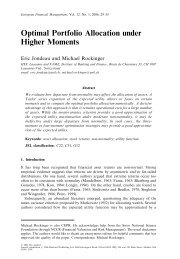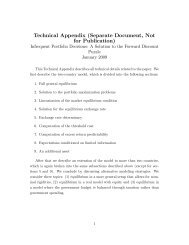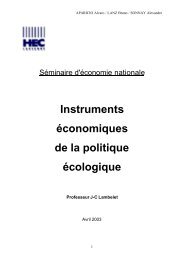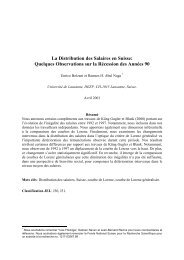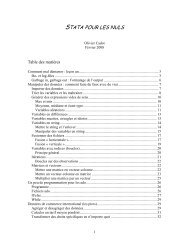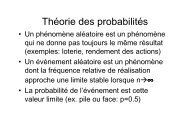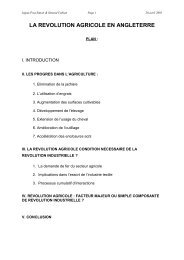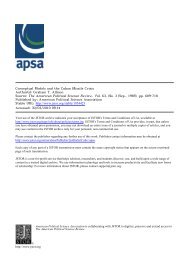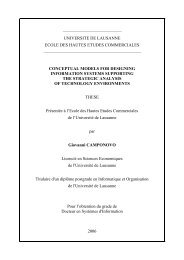The Business Model Ontology - a proposition in a design ... - HEC
The Business Model Ontology - a proposition in a design ... - HEC
The Business Model Ontology - a proposition in a design ... - HEC
You also want an ePaper? Increase the reach of your titles
YUMPU automatically turns print PDFs into web optimized ePapers that Google loves.
<strong>The</strong> <strong>Bus<strong>in</strong>ess</strong> <strong>Model</strong> <strong>Ontology</strong> - a <strong>proposition</strong> <strong>in</strong> a <strong>design</strong> science approach<br />
Implementation<br />
Capabilities<br />
Susta<strong>in</strong>ability<br />
Is the quality of the team high?<br />
To what extent are the firm's capabilities:<br />
Dist<strong>in</strong>ctive?<br />
Inimitable?<br />
Extendable to other product markets?<br />
Has the firm been able to ma<strong>in</strong>ta<strong>in</strong> or extend its lead <strong>in</strong> its <strong>in</strong>dustry?<br />
Table 14: Apprais<strong>in</strong>g a <strong>Bus<strong>in</strong>ess</strong> <strong>Model</strong>: Component Measures (Afuah and Tucci 2003)<br />
<strong>The</strong> probably most advanced <strong>proposition</strong> for evaluat<strong>in</strong>g bus<strong>in</strong>ess models is outl<strong>in</strong>ed by Gordijn (2002)<br />
and is part of their e 3 -value method. <strong>The</strong>y propose study<strong>in</strong>g the economic feasibility of an e-bus<strong>in</strong>ess<br />
idea <strong>in</strong> quantitative terms by creat<strong>in</strong>g a profit sheet and assess<strong>in</strong>g the value of objects for all actors<br />
<strong>in</strong>volved. This is possible because their method is highly actor-, network- and value-centered and<br />
focuses and the value exchanges among bus<strong>in</strong>ess model participants (cf. 3.1.5). <strong>The</strong> authors admit that<br />
this evaluation serves for build<strong>in</strong>g confidence <strong>in</strong> an e-bus<strong>in</strong>ess idea rather than calculat<strong>in</strong>g precise<br />
profit estimations, which would be unrealistic. Further, Gordijn <strong>in</strong>troduces an additional confidencebuild<strong>in</strong>g<br />
step through the elaboration of “whati-if” scenarios. This helps stakeholders understand the<br />
sensitivity of e-bus<strong>in</strong>ess models with respect to its parameters, such as f<strong>in</strong>ancials, future trends or<br />
customer behavior.<br />
3.2 ONTOLOGIES<br />
<strong>The</strong> second field of research that has <strong>in</strong>fluenced this dissertation is ontologies, particularly <strong>in</strong> IS. I<br />
outl<strong>in</strong>e some of the exist<strong>in</strong>g work <strong>in</strong> the follow<strong>in</strong>g l<strong>in</strong>es.<br />
<strong>The</strong> term <strong>Ontology</strong> (with a capital "O") has its orig<strong>in</strong> <strong>in</strong> philosophy and denotes the philosophical<br />
discipl<strong>in</strong>e that deals with the nature and the organization of reality, contrary to Epistemology, which<br />
deals with the nature and sources of our knowledge (Guar<strong>in</strong>o and Giaretta 1995). In this thesis I use<br />
the term ontology (with the lowercase "o") to which I refer to with Gruber's (1993) def<strong>in</strong>ition as an<br />
explicit specification of a conceptualization. And I refer to a conceptualization as an <strong>in</strong>tentional<br />
semantic structure which encodes the implicit rules constra<strong>in</strong><strong>in</strong>g the structure of a piece of reality<br />
(Guar<strong>in</strong>o and Giaretta 1995).<br />
In order to clarify what an ontology is Ushold and Grun<strong>in</strong>ger (1996) refer to a quote from the SRKB<br />
(Shared Re-usable Knowledge Bases) electronic mail<strong>in</strong>g list that nicely summarizes its signification<br />
and the various forms and contexts it arises <strong>in</strong>.<br />
"Ontologies are agreements about shared conceptualizations. Shared<br />
conceptualizations <strong>in</strong>clude conceptual frameworks for model<strong>in</strong>g doma<strong>in</strong> knowledge;<br />
content-specific protocols for communication among <strong>in</strong>ter-operat<strong>in</strong>g agents; and<br />
agreements about the representation of particular doma<strong>in</strong> theories. In the knowledge<br />
shar<strong>in</strong>g context, ontologies are specified <strong>in</strong> the form of def<strong>in</strong>itions of representational<br />
vocabulary. A very simple case would be a type hierarchy, specify<strong>in</strong>g classes and their<br />
subsumption relationships. Relational database schemata also serve as ontologies by<br />
specify<strong>in</strong>g the relations that can exist <strong>in</strong> some shared database and the <strong>in</strong>tegrity<br />
constra<strong>in</strong>ts that must hold for them."<br />
After emerg<strong>in</strong>g <strong>in</strong> the artificial <strong>in</strong>telligence community and be<strong>in</strong>g applied to knowledge eng<strong>in</strong>eer<strong>in</strong>g<br />
ontologies are <strong>in</strong>creas<strong>in</strong>gly used <strong>in</strong> IS and IT. <strong>The</strong> ma<strong>in</strong> goal of apply<strong>in</strong>g ontologies <strong>in</strong> IS is the<br />
development and implementation of an explicit account of a shared understand<strong>in</strong>g <strong>in</strong> a given subject<br />
area <strong>in</strong> order to solve a problem (Ushold and Grun<strong>in</strong>ger 1996). Furthermore, Moschella (2002, p.25)<br />
describes IT ontologies as "logical supersets that comb<strong>in</strong>e metadata, taxonomies and semantics <strong>in</strong>to<br />
formal systems that can be encoded <strong>in</strong> software, enabl<strong>in</strong>g diverse Web applications to truly understand<br />
one another". He also <strong>in</strong>dicates that after the IT <strong>in</strong>dustry standardization efforts have focused on<br />
hardware, software and communication technologies the frontier is constantly shift<strong>in</strong>g towards<br />
<strong>in</strong>formation itself. Moschella (2002, p.25) believes this will "require the systematic management of<br />
bus<strong>in</strong>ess terms and their usage". <strong>The</strong> ma<strong>in</strong> set of problems this shift addresses can be found <strong>in</strong> a text by<br />
39




